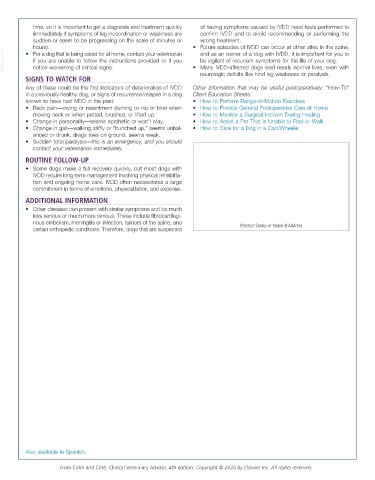Page 3051 - Cote clinical veterinary advisor dogs and cats 4th
P. 3051
time, so it is important to get a diagnosis and treatment quickly of having symptoms caused by IVDD need tests performed to
(immediately if symptoms of leg incoordination or weakness are confirm IVDD and to avoid recommending or performing the
sudden or seem to be progressing on the scale of minutes or wrong treatment.
hours). • Future episodes of IVDD can occur at other sites in the spine,
VetBooks.ir if you are unable to follow the instructions provided or if you • Many IVDD-affected dogs lead nearly normal lives, even with
• For a dog that is being cared for at home, contact your veterinarian
and as an owner of a dog with IVDD, it is important for you to
be vigilant of recurrent symptoms for the life of your dog.
notice worsening of clinical signs.
SIGNS TO WATCH FOR neurologic deficits like hind leg weakness or paralysis.
Any of these could be the first indicators of deterioration of IVDD Other information that may be useful postoperatively: “How-To”
in a previously healthy dog, or signs of recurrence/relapse in a dog Client Education Sheets:
known to have had IVDD in the past: • How to Perform Range-of-Motion Exercises
• Back pain—crying or resentment (turning to nip or bite) when • How to Provide General Postoperative Care at Home
moving neck or when petted, brushed, or lifted up. • How to Monitor a Surgical Incision During Healing
• Change in personality—seems apathetic or won’t play. • How to Assist a Pet That Is Unable to Rise or Walk
• Change in gait—walking stiffly or “hunched up,” seems unbal- • How to Care for a Dog in a Cart/Wheelie
anced or drunk, drags toes on ground, seems weak.
• Sudden total paralysis—this is an emergency, and you should
contact your veterinarian immediately.
ROUTINE FOLLOW-UP
• Some dogs make a full recovery quickly, but most dogs with
IVDD require long-term management involving physical rehabilita-
tion and ongoing home care. IVDD often necessitates a large
commitment in terms of emotions, physical labor, and expense.
ADDITIONAL INFORMATION
• Other diseases can present with similar symptoms and be much
less serious or much more serious. These include fibrocartilagi-
nous embolism, meningitis or infection, tumors of the spine, and
certain orthopedic conditions. Therefore, dogs that are suspected Practice Stamp or Name & Address
Also available in Spanish.
From Cohn and Côté: Clinical Veterinary Advisor, 4th edition. Copyright © 2020 by Elsevier Inc. All rights reserved.

